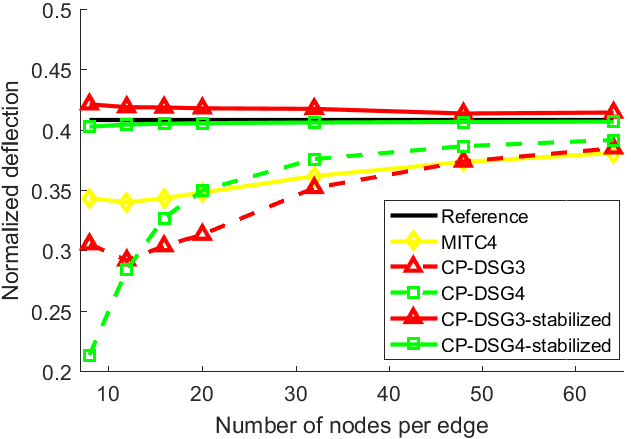A 4-node quadrilateral element with center-point based discrete shear gap (CP-DSG4)
Author affiliations
DOI:
https://doi.org/10.15625/0866-7136/16152Keywords:
discrete shear gap, four-node quadrilateral element, finite element method, Reissner-Mindlin plate theory, CP-DSG4Abstract
This work aims at presenting a novel four-node quadrilateral element, which is enhanced by integrating with discrete shear gap (DSG), for analysis of Reissner-Mindlin plates. In contrast to previous studies that are mainly based on three-node triangular elements, here we, for the first time, extend the DSG to four-node quadrilateral elements. We further integrate the fictitious point located at the center of element into the present formulation to eliminate the so-called anisotropy, leading to a simplified and efficient calculation of DSG, and that enhancement results in a novel approach named as "four-node quadrilateral element with center-point based discrete shear gap - CP-DSG4". The accuracy and efficiency of the CP-DSG4 are demonstrated through our numerical experiment, and its computed results are validated against those derived from the three-node triangular element using DSG, and other existing reference solutions.
Downloads
References
T. J. R. Hughes, M. Cohen, and M. Haroun. Reduced and selective integration techniques in finite element analysis of plates. Nuclear Engineering and Design, 46, (1), (1978), pp. 203–222.
S.-H. Kim and C.-K. Choi. Improvement of quadratic finite element for Mindlin plate bending. International Journal for Numerical Methods in Engineering, 34, (1), (1992), pp. 197–208.
D. Wan, D. Hu, S. Natarajan, S. P. A. Bordas, and T. Long. A linear smoothed quadratic finite element for the analysis of laminated composite Reissner-Mindlin plates. Composite Structures, 180, (2017), pp. 395–411.
K.-J. Bathe and E. Dvorkin. A four-node plate bending element based on Mindlin/Reissner plate theory and a mixed interpolation. International Journal for Numerical Methods in Engineering, 21, (2), (1985), pp. 367–383.
K.-J. Bathe, F. Brezzi, and S.W. Cho. The MITC7 and MITC9 plate bending elements. Computers & Structures, 32, (3-4), (1989), pp. 797–814.
P. S. Lee and K.-J. Bathe. Development of MITC isotropic triangular shell finite elements. Computers & Structures, 82, (11-12), (2004), pp. 945–962.
R. P. R. Cardoso, J.W. Yoon, M. Mahardika, S. Choudry, R. J. A. de Sousa, and R. A. F. Valente. Enhanced assumed strain (EAS) and assumed natural strain (ANS) methods for one-point quadrature solid-shell elements. International Journal for Numerical Methods in Engineering, 75, (2), (2007), pp. 156–187.
L. M. Li, Y. H. Peng, and D. Y. Li. A stabilized underintegrated enhanced assumed strain solid-shell element for geometrically nonlinear plate/shell analysis. Finite Element Analysis and Design, 47, (5), (2011), pp. 511–518.
K.-U. Bletzinger, M. Bischoff, and E. Ramm. A unified approach for shear-locking-free triangular and rectangular shell finite elements. Computers & Structures, 75, (2000), pp. 321–334.
P. S. Lee, H.-C. Noh, and K.-J. Bathe. Insight into 3-node triangular shell finite elements: the effects of element isotropy and mesh patterns. Computers & Structures, 85, (7-8), (2007), pp. 404–418.
X. Y. Cui and L. Tian. A central point-based discrete shear gap method for plates and shells analysis using triangular elements. International Journal of Applied Mechanics, 09, (2017).
S. Shojaee, N. Valizadeh, E. Izadpanah, Q. T. Bui, and T. V. Vu. Free vibration and buckling analysis of laminated composite plates using the NURBS-based isogeometric finite element method. Composite Structures, 94, (5), (2012), pp. 1677–1693.
L. Beirao da Veiga, T. J. R. Hughes, J. Kiendl, C. Lovadina, J. Niiranen, A. Reali, and H. Speleers. A locking-free model for Reissner–Mindlin plates: Analysis and isogeometric implementation via NURBS and triangular NURPS. Mathematical Models and Methods in Applied Sciences, 25, (8), (2015), pp. 1519–1551.
T. Q. Bui, D. H. Doan, T. V. Do, S. Hirose, and D. D. Nguyen. High frequency modes meshfree analysis of Reissner–Mindlin plates. Journal of Science: Advanced Materials and Devices, 1, (3), (2016), pp. 400–412.
T. T. Truong, V. S. Lo, M. N. Nguyen, N. T. Nguyen, and D. K. Nguyen. Evaluation of fracture parameters in cracked plates using an extended meshfree method. Engineering Fracture Mechanics, 247, (2021).
H. Nguyen-Xuan, T. Rabczuk, N. Nguyen-Thanh, T. Nguyen-Thoi, and S. P. A. Bordas. A node-based smoothed finite element method with stabilized discrete shear gap technique for analysis of Reissner-Mindlin plates. Computational Mechanics, 46, (2010), pp. 679–701.
J. Videla, S. Natarajan, and S. P. A. Bordas. A new locking-free polygonal plate element for thin and thick plates based on Reissner-Mindlin plate theory and assumed shear strain fields. Computer & Structures, 220, (2019), pp. 32–42.
T. Nguyen-Thoi, P. Phung-Van, H. Nguyen-Xuan, and C. Thai-Hoang. A cell-based smoothed discrete shear gap method using triangular elements for static and free vibration analyses of Reissner-Mindlin plates. International Journal for Numerical Methods in Engineering, 91, (7), (2012), pp. 705–741.
M. Lyly, R. Stenberg, and T. Vihinen. A stable bilinear element for the Reissner-Mindlin plate model. Computer Methods in Applied Mechanics and Engineering, 110, (3-4), (1993), pp. 343–357.
S. Timoshenko and S.Woinowsky-Kriger. Theory of plates and shells. McGraw-Hill, (1940).
A. Ayad and A. Rigolot. An improved four-node hybrid-mixed element based upon Mindlin’s plate theory. International Journal for Numerical Methods in Engineering, 55, (6), (2002), pp. 705–731.
L. S. D. Morley. Skew plates and structures. Pergamon Press, (1963).

Downloads
Published
How to Cite
Issue
Section
License

This work is licensed under a Creative Commons Attribution-ShareAlike 4.0 International License.









